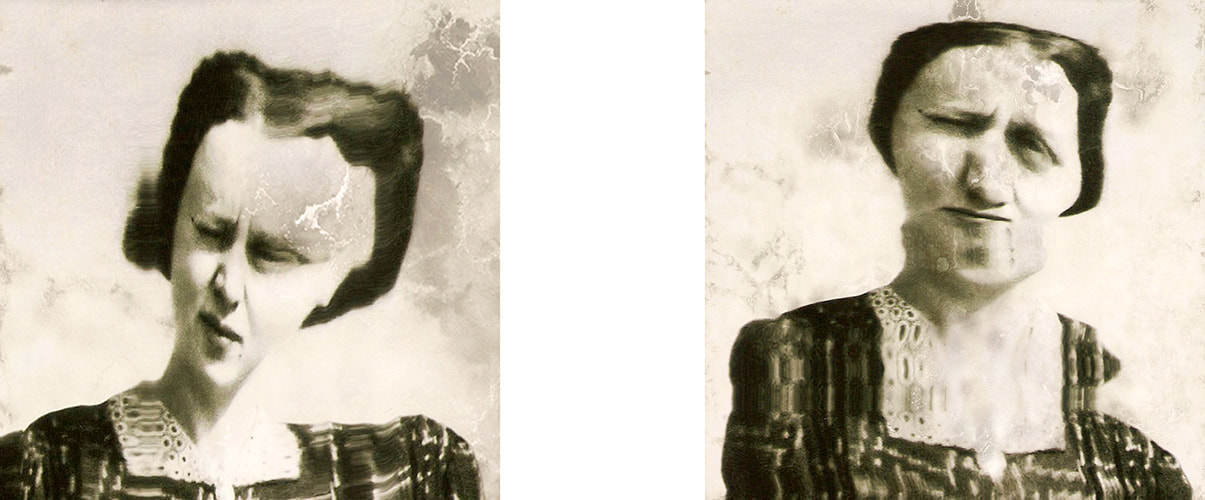La regressione
|
2018 | digital manipulation | photographs immersed in stagnant water | true giclèe prints on baryta paper | 11x11 cm each
“The original death, the one before life in which the stagnant water is basically the maternal water, and the cosmological death, death by destruction of life” Michel Imberty A vintage photograph found in an old album shows the portrait of an unknown woman. This is the image chosen to symbolize the existence of the young woman who lived in the family home, as a replacement for one of the few visual testimonies of this person, perhaps lost due to her early death. In fact, the young woman drowned in the waters of the pond adjacent to the house. The photograph of the woman is scrupulously and almost obsessively investigated, a slow and singular research, in which copies of the image are immersed in the water collected from the well which now replaces the pond. The woman becomes an idealized figure, a face with missing details, with distorted features, broken down on itself so much that it loses its initial appearance. Water is perceived as an element capable of operating on images by reviving part of the photographed subject; a substance that creeps into photos, which slowly consumes like a discolouring solvent. And the woman seems to undergo a process of metamorphosis, she seems to merge with that natural element, realizing the rêverie of being an integral part of nature, of canceling herself in the aquatic element, in short, of giving up her own self. Where water, as the absolute protagonist, welcomes the young body into itself without cruelty or pain, but like a mother’s womb, as if it were, her death, a regressus ad uterum. A peace achieved rather than a tragic death. |
2018 | manipolazione digitale | fotografie immerse in acqua stagnante | stampe true giclèe su carta baritata | 11x11 cm ognuna
“La morte originaria, quella anteriore alla vita in cui l’acqua stagnante è in fondo l’acqua materna, e la morte cosmologica, la morte per distruzione della vita” Michel Imberty Una fotografia d’epoca trovata in un vecchio album mostra il ritratto di una sconosciuta. Si tratta dell’immagine scelta per simboleggiare l’esistenza della giovane donna che ha vissuto nella casa di famiglia, in sostituzione a una delle poche testimonianze visive di questa persona, forse andate perdute a causa della sua morte precoce. La giovane infatti, annegò nelle acque dello stagno adiacente alla casa. La fotografia della donna viene indagata in maniera scrupolosa e quasi ossessiva, ricerca lenta e singolare, in cui le copie dell’immagine vengono immerse nelle acque raccolte dal pozzo che oggi si trova nei pressi dello stagno. La donna diventa una figura idealizzata, un volto dai dettagli mancanti, dai lineamenti distorti, scomposto su se stesso tanto da perdere il proprio aspetto iniziale. L’acqua viene percepita come un elemento in grado di operare sulle immagini facendo rivivere parte del soggetto fotografato; una sostanza che si insinua nelle foto, che consuma lentamente come un solvente che scolora. E la donna sembra subire un processo di metamorfosi, sembra fondersi con quell’elemento naturale, realizzando la rêverie di essere parte integrante della natura, di annullarsi nell’elemento acquatico, di rinunciare, insomma, al proprio io. Dove l’acqua, da assoluta protagonista, accoglie in sé il giovane corpo senza crudeltà né dolore, ma come un grembo materno, quasi fosse, la sua morte, un regressus ad uterum. Una pace raggiunta piuttosto che una morte tragica. |


